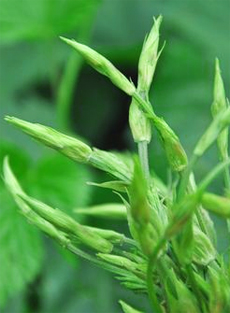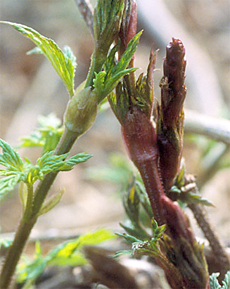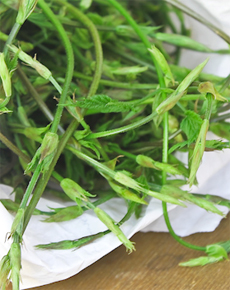|
|
Health benefits of world costliest vegetable "Hopshoots"
 Hopshoots
are the young growing tip of the hop, which is itself a perennial plant. The hop
dies back completely in winter, but as soon as the ground warms up in March, the
hop shoot pushes through the soil. The hop shoots start out as a dark purple
colour, but soon turn bright green and grow into curling tendrils, known as the
tips. Given some moisture and sunshine, the hop shoots grow rapidly � up to 6
inches a day. For a few weeks in March, the hop shoots provide a delicious
vegetable, before developing into the hopbine which climbs up the netting to
reach the top in July. The female plants produce a flower, known as a �burr�,
from which the cones develop, ready for harvest in early September. Hopshoots
are the young growing tip of the hop, which is itself a perennial plant. The hop
dies back completely in winter, but as soon as the ground warms up in March, the
hop shoot pushes through the soil. The hop shoots start out as a dark purple
colour, but soon turn bright green and grow into curling tendrils, known as the
tips. Given some moisture and sunshine, the hop shoots grow rapidly � up to 6
inches a day. For a few weeks in March, the hop shoots provide a delicious
vegetable, before developing into the hopbine which climbs up the netting to
reach the top in July. The female plants produce a flower, known as a �burr�,
from which the cones develop, ready for harvest in early September.
Hop shoots are a seasonal delicacy, being almost the first green spring
vegetable. Italians particularly relish them. The first shoots of the year are
sold by auction and can reach almost 1000 euro per kilogramme. Hop shoots,
sometimes known as hop �asparagus� or �salsify�, have a delicate fresh flavour
and just need quick steaming with butter, or stir-frying with chives and garlic.
In Italy, they are cooked with arborio rice to make risotto di Bruscandoli. They
can also flavor a soup or butter sauce, or be a beautiful garnish to a dish. To
be eaten as a vegetable, hop shoots need to be grown organically, but this is
not easy, as the hop shoots are so tasty, that aphids can sometimes take the
whole crop.
The most expensive of these is widely thought to be 'hop asparagus'. In
fact, a farmer in England sold hop asparagus for as much as �150 per kilo in
2001. Hop asparagus is one of the smallest varieties of asparagus and has a
diameter equal to about one third of more common asparagus. Hop asparagus is also
one of the oldest cultivated root vegetables in the world. It is only farmed in
four known areas. Asparagus growing can be traced back to ancient Egypt. One
reason that is attributed to the high cost of the vegetable is that there are
only certain types of hops that can be used to grow it. Hops themselves are
primarily used in beer making and there are a number of different varieties.
The shoots, which resemble purple-tinged asparagus with rows of tiny, soft
spines, have been used medicinally for thousands of years. The Egyptians used
hops to treat liver disease and digestive complaints. Wet hop compresses were
said to ease pain and inflammation.
Now, scientists have discovered chemicals in hop shoots that appear to ease the
symptoms of the menopause, and even help stop the proliferation of cancer cells.
A research team lead by Professor Stuart Milligan from King's College London
managed to isolate and identify a hormonally active compound in the hop called
hopein (technically known as 8-prenylnaringenin), which is one of the most
potent phyto-oestrogens. These chemicals have similar structures to the female
hormone oestrogen, and can mimic its effects.
According to Maryon Stewart, founder of the Women's Nutritional Advisory
Service, phyto-oestrogens are crucial because they help women top up their
oestrogen levels without having to resort to hormone replacement therapy. "Our
intake of foods containing phyto-oestrogens in Western countries is negligible,
compared with Asian women, who consume between 50 and 100 grams of phyto-oestrogen
each day," she says.
Experiments have also shown that hops contain a chemical called lupulin, a
strong anti-cancer compound. Lupulin contains a bitter acid complex including
humulone lupulone and valerenic acid, which are mild sedatives.
Xanthohumol, which is also present in hop shoots, is being studied for its
anti-cancer properties. It seems to slow down the promotion and progression of
certain tumour cells. Hops, like their cannabis plant cousin, relax the smooth
muscles and act as a sedative. In the past, pillows filled with hops were used
to ease insomnia and nerve disorders.
Whether you are looking for a buzz or a gourmet meal, the best way to eat
young hop shoots is quickly steamed or boiled and drizzled with butter or lemon.
They are best eaten soon after being plucked from the ground, when they are
sweeter.
Hop shoots grown outdoors in broad daylight tend to be tougher and hairier, with
a more pronounced flavour, than those grown in darkness. Tough stems can be
softened by blanching in the pot for 10-15 minutes.
In the past, aficionados of hop shoots had to buy them at market stalls or farms
in the South-East. Now, Booths, with shops across the North, has become the
first supermarket chain to stock the vegetable, until the season draws to a
close at the end of this month.
I enjoyed them, and I definitely felt an effect. As soon as I swallowed my first
mouthful, my lips started to tingle and my heart started beating faster. But who
knows? It could have been from pure pleasure.
Medicinal Action and Uses of Hops:
Hops have tonic, nervine, diuretic and anodyne properties:Their volatile oil
produces sedative and soporific effects, and the Lupamaric acid or bitter
principle is stomachic and tonic. For this reason Hops improve the appetite and
promote sleep.
The official preparations are an infusion and a tincture. The infusion is
employed as a vehicle, especially for bitters and tonics: the tincture is
stomachic and is used to improve the appetite and digestion. Both preparations
have been considered to be sedative, were formerly much given in nervousness and
hysteria and at bedtime to induce sleep; in cases of nervousness, delirium and
inflammation being considered to produce a most soothing effect, frequently
procuring for the patient sleep after long periods of sleeplessness in
overwrought conditions of the brain.
The bitter principle in the Hop proves one of the most efficacious vegetable
bitters obtainable. An infusion of 1/2 oz. Hops to 1 pint of water will be found
the proper quantity for ordinary use. It has proved of great service also in
heart disease, fits, neuralgia and nervous disorders, besides being a useful
tonic in indigestion, jaundice, and stomach and liver affections generally. It
gives prompt ease to an irritable bladder, and is said to be an excellent drink
in cases of delirium tremens. Sherry in which some Hops have been steeped makes
a capital stomachic cordial.
A pillow of warm Hops will often relieve toothache and earache and allay nervous
irritation.
Sluggish livers:An infusion of the leaves, strobiles and stalks, as Hop Tea,
taken by the wineglassful two or three times daily in the early spring, is good
for sluggish livers. Hop Tea in the leaf, as frequently sold by grocers,
consists of Kentish Hop leaves, dried, crushed under rollers and then mixed with
ordinary Ceylon or Indian Tea. The infusion combines the refreshment of the one
herb with the sleepinducing virtues of the other.
Hop juice cleanses the blood:and for calculus trouble nothing better can be
found than the bitter principle of the Hop. A decoction of the root has been
esteemed as of equal benefit with Sarsaparilla.
As an external remedy, an infusion of Hops is much in demand in combination with
chamomile flowers or poppy heads as a fomentation for swelling of a painful
nature, inflammation, neuralgic and rheumatic pains, bruises, boils and
gatherings. It removes pain and allays inflammation in a very short time. The
Hops may also be applied as a poultice.
The drug Lupulin is an aromatic bitter and is reputed to be midly sedative,
inducing sleep without causing headache.
It is occasionally administered as a hypnotic, either in pills with alcohol, or
enclosed in a cachet.
Preparations of Lupulin are not much used in this country, although official,
but in the United States they are considered preferable for internal use.
Medicinal virtues:
 It will open obstructions of the liver and spleen, cleansethe blood, loosen the
belly, cleanse the reins from gravel and provoke the urine. The decoction of the
tops cures the itch and breakings out of the body, tetters, ringworms, spreading
sores, rnorphew and all discolourings of the skin.The decoction of the flowers
and tops helps to expel poison. Half a dram (89o mg) of the seed in powder,
taken in drink, kills worms in the body, brings down women's courses and expels
urine. A syrup made of the juice and sugar cures yellow jaundice and eases the
headache that comes of heat. It will open obstructions of the liver and spleen, cleansethe blood, loosen the
belly, cleanse the reins from gravel and provoke the urine. The decoction of the
tops cures the itch and breakings out of the body, tetters, ringworms, spreading
sores, rnorphew and all discolourings of the skin.The decoction of the flowers
and tops helps to expel poison. Half a dram (89o mg) of the seed in powder,
taken in drink, kills worms in the body, brings down women's courses and expels
urine. A syrup made of the juice and sugar cures yellow jaundice and eases the
headache that comes of heat.
Hops' best known medicinal function is as a mild sedative and sleep aid. For
centuries pillows filled with hops have been prescribed for people who have
difficulty falling asleep. Hops extracts taken orally are also said to promote
sleep. Hops are chemically complex and contain many different compounds.
Scientists have separated out several components that are sedative in nature,
although it is not clear whether hops contain enough of these compounds to
actually make a person sleepy. Studies are ongoing, but the German Federal
Health Agency's Commission E, established in 1978 to independently review and
evaluate scientific literature and case studies pertaining to herb and plant
medications, has approved hops for sleep problems, restlessness, and anxiety.
Hops belongs to the same family of herbs as marijuana, and some people claim it
produces a mild, relaxed, euphoric feeling when smoked. There is no scientific
evidence for this claim.
The second major use of hops is as an aid to digestion. It has been used for
centuries in both traditional Chinese medicine and Native American healing to
stimulate the appetite, ease digestion, and aid in relieving colic. It is
believed that hops stimulates the secretions of the stomach.
The German E Commission has also concluded that hops may act as a digestive aid.
Scientists have isolated another extract from the plant that in the laboratory
inhibits spasms in the digestive tract and other smooth muscle. Follow-up
studies in people have not yet been done.
Chinese healers use hops to treat tuberculosis and as an antibiotic. Test-tube
studies show that the bitter acids in hops inhibit the growth of certain
bacteria and fungi, including the common bacteria Staphylococcis aureus
(responsible for staph infections) and Bacillus subtilis; but do not inhibit
Escherichia coli, a bacterium that causes digestive upsets. This antibacterial
action may account for the preservative effect of hops in brewed beer. A 1999
study also showed that some compounds isolated from hops were effective in
test-tube studies in reducing the proliferation of certain types of human breast
and ovarian cancer cells. As of 2002, hops extract is being studied as a
possible cancer chemopreventive.
There has been much debate in the healing community about whether hops contain a
compound related to or easily converted into estrogen, the main female hormone.
Some herbalists believe that the presence of an estrogenic compound accounts for
the dampening of male sexual arousal and the control of sexual nervous tension
ascribed to fresh hops. Other herbalists disagree, maintaining that those
effects are related only to the relaxing or sedative properties of hops. In
2002, however, a team of British researchers reported on the activity of a
phytoestrogen that was recently discovered in the female flowers of hops plants.
The compound, known as 8-prenylnaringenin, appears to be stronger than
previously identified phytoestrogens.
Nutrition Benefits Of Eating Hops
 Hops is said to have hypnotic properties. There have been many researches
conducted to evaluate the effect of hops on the sleep quality of a person.
Consumptions of hops is said to cure problems of insomnia in a person. Hops is said to have hypnotic properties. There have been many researches
conducted to evaluate the effect of hops on the sleep quality of a person.
Consumptions of hops is said to cure problems of insomnia in a person.
Hops is not a major herbal antibiotic. However, the anti-bacterial factors
present in hops help in preventing infections. In cases of small cuts and
scrapes, some crushed flower tops when applied on the wound can provide instant
relief.
Hop was used as a sedative in traditional times. It was used as an agent to
relax and soothe a person and reduce the effects of anxiety. There are few
animal studies that suggest the sedative properties of hop; however, there has
been limited human research in this area.
Hops is said to contain anti-inflammatory properties. Hence, it is beneficial in
the treatment of arthritis.
The alcoholic hop extracts have been used by doctors in China in different
dosages to cure different forms of diseases, such as leprosy, pulmonary
tuberculosis and acute bacterial dysentery. Lupulon and Humulon are some of the
other antibiotic bitter acids present in the herb, which provide partial
effectiveness in treatments involving hops.
Hops is quite effective in treating dandruff problem. The derived hop extracts
when rubbed into the scalp help to deal with this problem. For this, you need to
shampoo your hair. Once washed, apply the hop extract properly. Then, rinse the
hair using plain water. This treatment helps in the prevention and control of
dandruff and flaky skin in the scalp.
Hops help in relaxing and soothing the muscles in the digestive tract.
Hops is good for people suffering from anxiety, hyperactivity, nervousness, body
pain, restlessness, sexually transmitted disease, shock, stress, toothaches and
different ulcers.
Hops consumption proves to be useful in reducing the risk of cardiovascular
diseaases .
Culinary Uses
Hops shoots can be used to serve and prepare different types of meals. You can
prepare hop shoots by boiling them in water for 2 to 3 minutes. Once the shoots
are boiled, change the water and steam the spears until tender. These cooked
hops shoots can be served with some melted butter or cheese sauce for lunch or
dinner.
Hops is an essential ingredient that is used in brewing beer. Apart from that,
it is also used to season beer. The bitterness in beer is because of the resin
in the hop cone�s lupulin glands.
The oils and other extracts from hops are used in different products. It is one
of the ingredients used to flavor yeast, candy and gelatins. It is also used to
spice up ice creams and puddings, baked goods, chewing gums and even different
condiments.
Dated 26 April 2013
|
|
|
|
|









